April 26, 2023
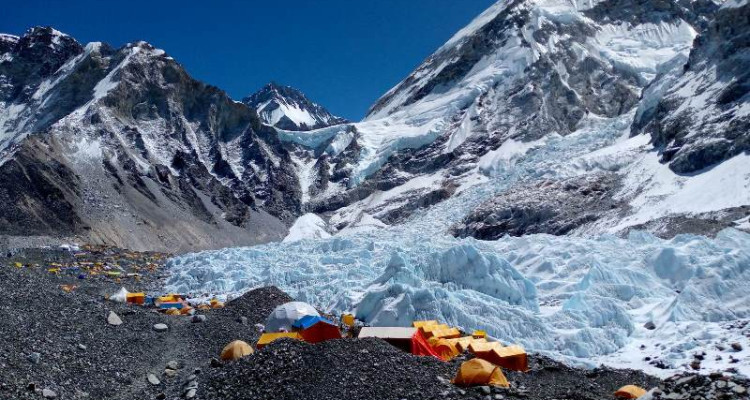
Are you looking for a thrilling adventure that involves hiking in the mountains? Then trekking in Nepal might be the perfect activity for you! Nepal offers a range of fun and challenging trekking options for all experience levels, with some of the best mountain views in the world.
However, it’s important to keep in mind that Nepal can be a rugged and challenging destination for trekkers. That’s why it’s essential to be well-informed about all your options before committing to a particular hike. In this article, we’ll guide you through everything you need to know about trekking in Nepal, including when to go, where to go, how to go, and what to bring.
It’s worth noting that as of April 1st, 2023, the Nepal Tourist Board (NTB) has made changes to the trekking laws for all foreign trekkers, cyclists, and mountain climbers visiting Nepal’s mountain regions and national parks. From now on, all trekkers, whether solo or in a group, must be accompanied by a licensed guide. To find out more about what this means for you, make sure to read our update on the Nepal trekking requirements.
If you’re planning to go trekking in Nepal, it’s important to choose the right time to go. Nepal has a distinct wet and dry season, and the weather can vary significantly depending on the time of year and the region you’re trekking in.
The best time to go trekking in Nepal is during the dry season, which runs from October to May. During this time, the weather is generally clear and dry, making it ideal for trekking. The busiest trekking season in Nepal is from October to November, which is when the weather is at its best and the mountain views are the clearest. However, it’s also the most crowded time, so if you prefer to avoid the crowds, consider going in the shoulder seasons of March to May or September to November.
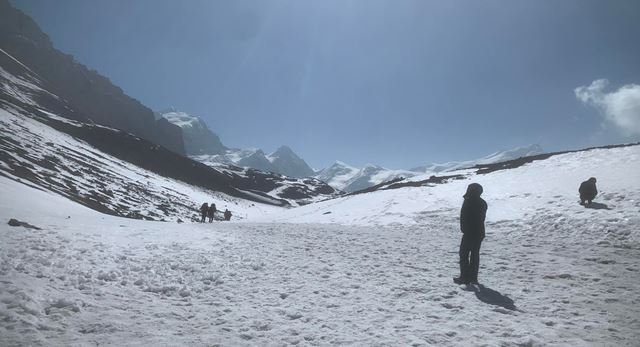
Over the pass in Annapurna round Trek
The weather in Nepal can vary significantly depending on the region you’re trekking in. For example, the Everest region has a colder and drier climate than the Annapurna region, which is more humid and receives more rainfall. It’s important to research the climate of the region you’re planning to trek in and pack accordingly.
In conclusion, the best time to go trekking in Nepal is during the dry season from October to May. However, it’s also important to consider the weather and climate of the region you’re trekking in and pack appropriately. Whether you’re planning to trek to Everest Base Camp or explore the Annapurna region, Nepal offers some of the most stunning trekking experiences in the world.
Trekking in Nepal is a popular adventure activity, but it’s important to keep safety in mind to ensure a successful and enjoyable experience. Here are some safety tips for trekking in Nepal:
By following these safety tips, you can have a safe and enjoyable trekking experience in Nepal.

Hiring a guide or porter for a beginner trek in Nepal can be a great help for those who are unfamiliar with the terrain, culture, and language of the region. A guide can offer valuable insights into the local culture and history, as well as provide navigation assistance on the trail. They can also help with accommodations and meals, as well as provide first aid if necessary. Porters, on the other hand, can carry your backpack, making the trek easier and more enjoyable. This is especially helpful for those who are not used to carrying heavy loads at high altitudes. When hiring a guide or porter, it is important to do research and choose a reputable company or individual. Look for reviews and recommendations from other trekkers, and make sure to discuss the scope of the services and the fees in advance. Hiring a guide or porter can add to the cost of your trek, but the benefits of having an experienced local with you can greatly enhance your trekking experience.
While trekking in Nepal as a beginner, you can expect to stay in local tea houses along the trail. Tea houses are small, family-run lodges that offer basic accommodations and meals for trekkers. These accommodations vary in quality, but are typically clean and comfortable. Most tea houses offer shared rooms with simple furnishings like a bed, blankets, and pillows. Some tea houses have attached bathrooms, but most have shared toilets and bathing facilities.
In terms of food, most tea houses offer a menu of Nepali and international dishes. The food is typically simple, but filling and tasty. Some common dishes include dal bhat (a lentil soup served with rice and vegetable curry), momos (Nepali dumplings), and noodle soup. Tea and coffee are also available, as well as snacks like biscuits, chocolate, and energy bars.
It is important to keep in mind that the availability of food and accommodations can be limited in more remote areas, and prices may be higher than in urban areas. It is recommended to carry some cash with you on the trek, as there are no ATMs or banks along the trail. Some tea houses also offer charging stations for electronic devices, but it is best to bring a portable charger just in case.
Overall, while trekking in Nepal as a beginner, you can expect simple yet comfortable accommodations and hearty, filling meals in local tea houses along the trail.
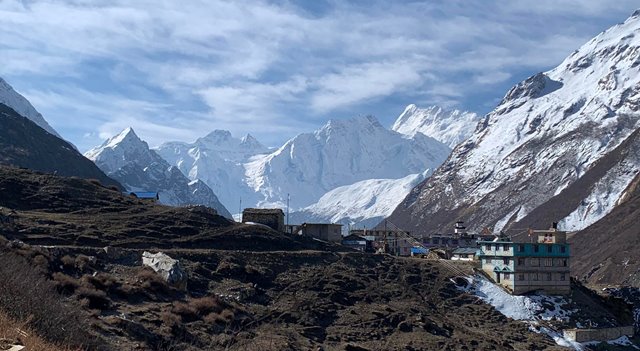
During Annapurna round trek 2023
Budgeting is an essential part of planning a trek in Nepal, especially for beginners who may be unsure of what costs to expect. Here are some costs to consider when budgeting for a beginner trek in Nepal:
Overall, the cost of a beginner trek in Nepal can range from $500-$1500 USD depending on the length of the trek, level of comfort, and other factors. It is important to budget for unexpected expenses and bring some extra cash in case of emergency situations.
Nepal is a country with a rich cultural heritage and diverse customs. Here are some important aspects of local culture and customs to keep in mind when visiting Nepal:
By respecting local culture and customs, visitors to Nepal can have a more enriching and authentic travel experience.
Trekking in Nepal requires a good level of physical fitness, as you will be walking for several hours a day at high altitudes. Here are some tips for physical preparation for trekking in Nepal:
Remember, the key to physical preparation for trekking in Nepal is to start early and gradually build up your fitness level. With the right preparation, you can enjoy the stunning mountain landscapes and cultural experiences that Nepal has to offer.
Altitude sickness, also known as acute mountain sickness (AMS), is a condition that can occur when you ascend to high altitudes too quickly. It is caused by a lack of oxygen and can be serious if left untreated. Here are some tips on how to prevent and treat altitude sickness:
Symptoms:
Prevention:
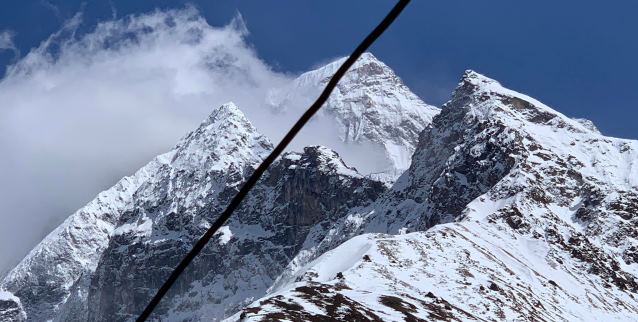
Nepal Himalaya
Remember, altitude sickness can be serious and potentially life-threatening, so it is important to take it seriously and take preventative measures to avoid it. With proper preparation and awareness, you can enjoy the stunning mountain landscapes of Nepal safely.
Nepal offers a range of trekking options, from short and easy hikes to challenging multi-day treks. The most popular trekking destination in Nepal is the Everest region, where you can trek to Everest Base Camp or climb to the summit of Everest. Other popular trekking destinations include the Annapurna region, Langtang region, and Upper Mustang.
Everest region Trek in Nepal
The Everest region in Nepal is one of the most popular trekking destinations in the world, attracting thousands of trekkers every year. Here’s a description of the different trekking trails in the Everest region:
This is the most popular trek in the Everest region and takes you to the base camp of the world’s highest mountain. The trek starts from Lukla and passes through Namche Bazaar, Tengboche Monastery, Dingboche, and Gorak Shep before reaching Everest Base Camp. The trek takes about 12-14 days and offers stunning views of the Khumbu Glacier, Mount Everest, and other Himalayan peaks.
This trek takes you to the beautiful Gokyo Lakes, which are located in the upper reaches of the Khumbu Valley. The trek starts from Lukla and passes through Namche Bazaar, Dole, and Machhermo before reaching Gokyo. From there, you can climb Gokyo Ri for stunning panoramic views of Mount Everest, Cho Oyu, and other peaks.
This is a challenging trek that takes you over three high mountain passes – Renjo La, Cho La, and Kongma La – before reaching Everest Base Camp. The trek starts from Lukla and passes through Namche Bazaar, Thame, Gokyo, and Chhukung before reaching Everest Base Camp. The trek takes about 16-18 days and offers breathtaking views of the Himalayas.
This is a shorter trek that takes you to the Everest View Hotel, which offers stunning panoramic views of Mount Everest and other Himalayan peaks. The trek starts from Lukla and passes through Namche Bazaar, Khumjung, and Khunde before reaching the Everest View Hotel. The trek takes about 5-7 days and is a great option for those who want to experience the beauty of the Everest region without trekking all the way to base camp.
In conclusion, the Everest region offers a range of trekking options to suit different preferences and fitness levels. Whether you’re looking for a challenging high-altitude trek or a shorter trek with stunning views, the Everest region has something for everyone.
Annapurna region treks in Nepal
The Annapurna region in Nepal is a popular trekking destination, known for its stunning mountain views and cultural experiences. The region offers a range of trekking options, from short and easy treks to challenging high-altitude treks. The most popular treks in the Annapurna region are:
This trek takes you around the entire Annapurna massif, offering stunning views of Annapurna and Dhaulagiri peaks. The trek starts from Besishahar and passes through Manang, Thorong La Pass, and Muktinath before reaching Jomsom. The trek takes about 16-20 days and is a challenging high-altitude trek.
This trek takes you to the base camp of Annapurna, offering stunning views of Annapurna and Machhapuchhre peaks. The trek starts from Nayapul and passes through Ghorepani, Tadapani, and Chhomrong before reaching Annapurna Base Camp. The trek takes about 10-14 days and is a moderate trek.
This is a shorter trek that takes you to Poon Hill, which offers stunning panoramic views of Annapurna and Dhaulagiri peaks. The trek starts from Nayapul and passes through Ghorepani before reaching Poon Hill. The trek takes about 4-6 days and is an easy trek.
This trek takes you off the beaten path to the base camp of Mardi Himal, offering stunning views of Annapurna and Machhapuchhre peaks. The trek starts from Kande and passes through Forest Camp, Low Camp, and High Camp before reaching Mardi Himal Base Camp. The trek takes about 6-8 days and is a moderate trek.
In conclusion, the Annapurna region offers a range of trekking options to suit different preferences and fitness levels. Whether you’re looking for a challenging high-altitude trek or a shorter trek with stunning views, the Annapurna region has something for everyone.
Langtang region Treks
Langtang region is a popular trekking destination in Nepal, known for its stunning mountain scenery, rich cultural heritage, and diverse flora and fauna. It is located in the north-central part of Nepal, close to the border with Tibet. The region offers a variety of trekking trails, ranging from easy to challenging, that take you through remote villages, lush forests, and high-altitude passes.
The most popular treks in the Langtang region include:
This is a moderate trek that takes you through beautiful forests and traditional villages before reaching the spectacular Langtang Valley. The trail offers stunning views of Langtang Lirung, Gang Chhenpo, and other peaks.
This is a challenging trek that takes you through the sacred lakes of Gosainkunda. The trail passes through beautiful rhododendron forests, rugged terrain, and high-altitude passes.
This is an easy trek that takes you through the beautiful Helambu region, famous for its unique culture and traditions. The trail offers stunning views of the Himalayas and passes through beautiful forests and traditional villages.
This is a combination trek that takes you through all three popular destinations of the Langtang region. The trail offers a great opportunity to explore the diverse landscapes, cultures, and traditions of the region.
Manaslu region Treks
The Manaslu region is a remote and beautiful area in Nepal that offers some of the most spectacular trekking experiences in the country. The region is home to the eighth highest mountain in the world, Mount Manaslu, as well as a range of other peaks and stunning natural scenery.
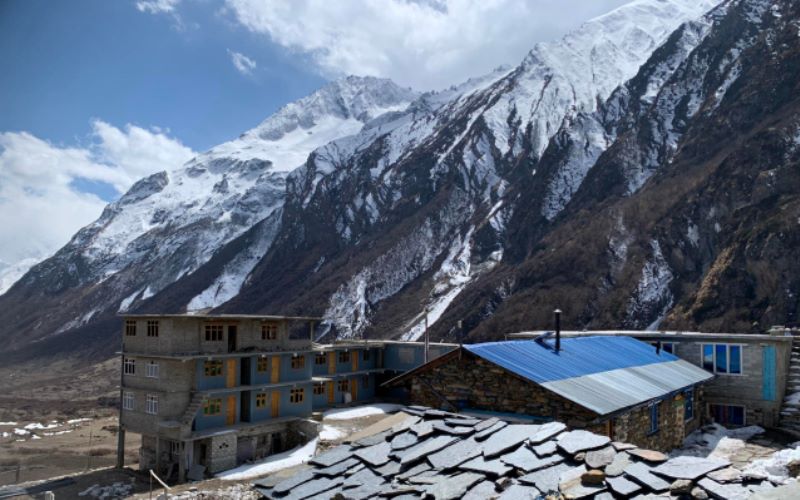
Tea Houses images while trekking in Annapurna region of Nepal
The most popular treks in the Manaslu region include:
This is a challenging trek that takes you around the entire Manaslu massif, offering stunning views of the mountain and the surrounding landscape. The trail passes through beautiful forests, traditional villages, and high-altitude passes.
This is a moderate trek that takes you through the hidden valley of Tsum, a remote and culturally rich region of the Manaslu area. The trail passes through beautiful landscapes and traditional Tibetan-style villages.
This is a challenging trek that takes you over the Rupina La pass, offering stunning views of the Manaslu massif and other peaks in the region. The trail passes through rugged terrain, beautiful forests, and traditional villages.
This is an easy trek that takes you through the lower region of the Manaslu area, offering a chance to experience the natural beauty and cultural traditions of the region. The trail passes through beautiful forests, traditional villages, and stunning landscapes.
Going trekking in Nepal can be an amazing adventure, but it requires some preparation and planning. Here are some steps to follow:
When preparing for a trekking trip, it’s important to pack appropriately to ensure you have everything you need while keeping your backpack lightweight. Here are some essential items to bring:
Remember to pack lightly and only bring what you need. Your guide or trekking agency can advise you on any additional gear or equipment that may be necessary for your specific trek.
Sure, here are brief descriptions and sample itineraries for the top 5 popular treks in Nepal:
Everest Base Camp Trek
The Everest Base Camp trek is one of the most iconic treks in the world, taking you to the base of the world’s highest mountain. The trek starts with a flight to Lukla and takes you through traditional Sherpa villages, across suspension bridges, and through breathtaking mountain landscapes. Highlights include reaching the summit of Kala Patthar for stunning views of Mount Everest, and visiting the Buddhist monastery at Tengboche.
Itinerary:
Day 1: Fly to Lukla and trek to Phakding
Day 2: Trek to Namche Bazaar
Day 3: Acclimatization day in Namche Bazaar
Day 4: Trek to Tengboche
Day 5: Trek to Dingboche
Day 6: Acclimatization day in Dingboche
Day 7: Trek to Lobuche
Day 8: Trek to Gorak Shep and hike to Everest Base Camp
Day 9: Hike to Kala Patthar and trek back to Gorak Shep
Day 10: Trek to Pheriche
Day 11: Trek to Namche Bazaar
Day 12: Trek to Lukla and fly back to Kathmandu
Annapurna Circuit Trek
The Annapurna Circuit trek is a classic route that takes you through a variety of landscapes, from lush subtropical forests to high-altitude desert. The trek offers stunning views of the Annapurna and Dhaulagiri mountain ranges, as well as the opportunity to experience local culture and hospitality. Highlights include crossing the Thorong La Pass at 5,416 meters and visiting the sacred Hindu temple at Muktinath.
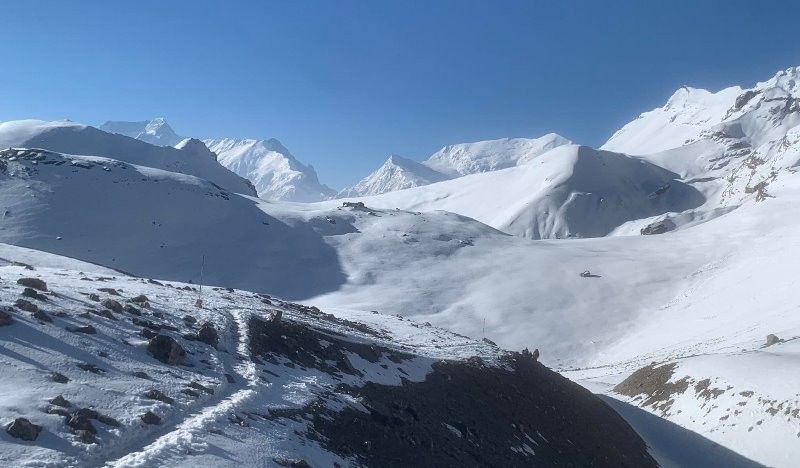
While snowing during Annapurna round trek 2023
Itinerary:
Day 1: Drive from Kathmandu to Besishahar and trek to Bhulbhule
Day 2: Trek to Jagat
Day 3: Trek to Dharapani
Day 4: Trek to Chame
Day 5: Trek to Pisang
Day 6: Trek to Manang
Day 7: Acclimatization day in Manang
Day 8: Trek to Yak Kharka
Day 9: Trek to Thorong Phedi
Day 10: Trek to Thorong La Pass and trek down to Muktinath
Day 11: Trek to Kagbeni
Day 12: Trek to Marpha
Day 13: Trek to Kalopani
Day 14: Trek to Tatopani
Day 15: Trek to Ghorepani
Day 16: Hike to Poon Hill and trek to Tadapani
Day 17: Trek to Ghandruk
Day 18: Trek to Nayapul and drive back to Pokhara
Langtang Valley Trek
The Langtang Valley trek takes you to the heart of the Langtang region, which was severely affected by the 2015 earthquake. The trek offers stunning views of the Langtang mountain range, as well as the opportunity to experience local Tamang culture and hospitality. Highlights include visiting the Kyanjin Gompa Buddhist monastery and hiking up to Tserko Ri for panoramic mountain views.
Itinerary:
Day 1: Drive from Kathmandu to Syabrubesi
Day 2: Trek to Lama Hotel
Day 3: Trek to Langtang village
Day 4: Trek to Kyanjin Gompa
Day 5: Hike to Tserko Ri and back to Kyanjin Gompa
Day 6: Trek back to Lama Hotel
Day 7: Lama Hotel to Sabrubeshi
Day 8: Sabrubeshi to Kathmandu by bus/jeep
In conclusion, trekking in Nepal is an incredible experience that offers breathtaking mountain views and challenging hiking opportunities. However, it’s important to be well-informed about the trekking laws and regulations in Nepal, as well as the best time to go, where to go, how to go, and what to bring. With the right preparation, you can embark on a safe and unforgettable adventure in the beautiful mountains of Nepal.